ChGK Question Base
The blogger writes that only the second word can be left in the title of a well-known manual. Write it.
Commentary: book by Maxim Ilyakhov and Lyudmila Sarycheva “Write, cut. How to create a strong text” is dedicated to creating short and capacious texts. Alexander Kulikov believes that the title of the book itself can also be approached with scissors.
For preflop pot-limit Omaha, there are several solver decisions made by different methods and for different rake conditions. In this article, we will use the PLO Trainer data for the rake corresponding to the z50 PokerStars. This is a high rake load that is not conducive to entering the pot after a raiser. Even in the big blind, you have to play pretty tight and fold against raises from early position a lot of hands that look good to call but have obvious disadvantages that do not allow them to be played positively.
So, suited cards with an ace, even relatively coordinated, but not having a high suit, look like trap hands: they are easy to call with, but difficult to win with. High pocket pairs with bad side cards fall into the same category. Many regulars who know preflop well prefer to cut down their defensive range and not play these hands even when the solver insists it's possible.
Winning GGPoker reg, who wished to remain anonymous:
Calls with hands like and guarantee us a post-flop play out of position, and I'm not a solver to bring them into winning hands. I am sure that you can’t just fit-o-fold with them: we have to bluff a lot and donk bet on a lot of textures and blockers.
However, not defending the big blind against a raise from MP on the first of these hands is, from the solver's point of view, the same expensive mistake as not opening from UTG, for example, with . Yes and with the right play, they will bring us 5 bb/100, which is good in the long run. Today we will try to see if you should be fearful of the difficulties that await us post-flop with hands that are inconvenient to defend. To do this, let's consider several textures, on which, in the opinion of the author of the article, difficulties may arise, and compare our intuitive solutions with the answers of the solver.
In all cases, we call in the BB with a 3.5bb open from a player in position two of the 6-max table.
AJT8
1)
We don't have a lead range on this flop since Villain has all the nuts, so we check 100% of our hands. Villain c-bets 3/4 of the pot.
At first glance, top pair and a gutshot should be enough to call, but having a nut flush draw blocker gives us some pretty interesting opportunities to play more actively. If we didn't have a backdoor flush draw in addition, we could turn the hand into a bluff and raise. I will say more: we would be obliged to play that way!
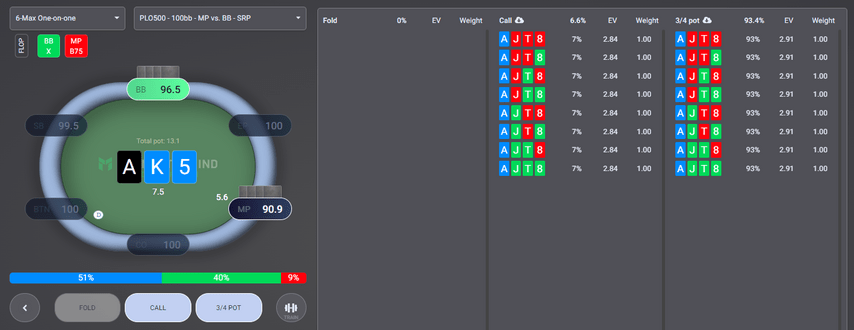
Against a 3-bet, of course, we calmly throw it away, but how to play after a call? Big pots are expensive mistakes; if you have already undertaken to win the pot, you must act very precisely.
We will continue the bluff only when the diamond comes out. Any other turn card – even a queen – requires us to check. We are ready to give up to the opponent's aggression without the nuts – even if the turn hits a ten or a jack, this gain is too little for us.
If we only had a backdoor on the flop, no nut blocker, that would be a solid call.
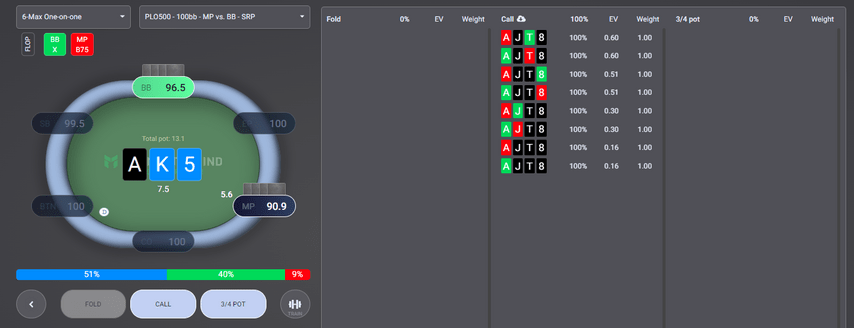
Then we are ready to endure one more bet if a spade comes, a second pair, or an ace. On many rivers with two pair or trips, we are going to bluff catch.
With the hand that we started to analyze initially, that is, with both the nut blocker and the backdoor, the solver uses both a call and a raise but calls much more often.
Finally, a naked top pair with a gutshot without a redraw, contrary to our initial assumption, simply folds:
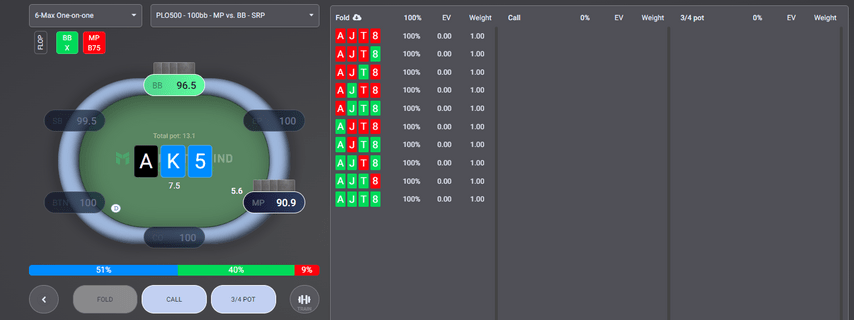
2)
Dry flop with top pair. Check-call without options, right? The solver has low-frequency leads or check-raises, but we won't discuss those.
How to continue on the turn killing our odds against an overpair?
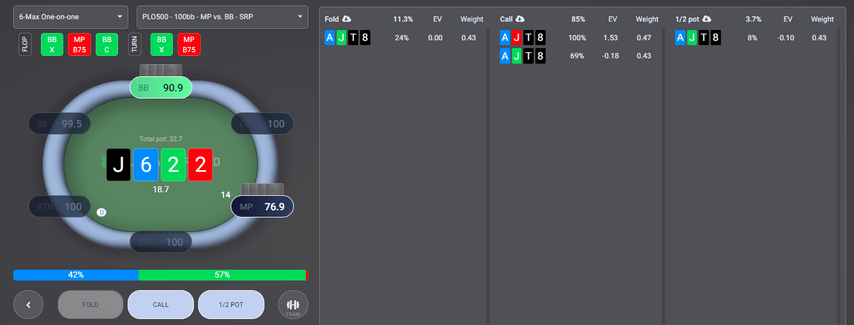
One more call looks the most reasonable because it's not difficult to guess aces in place of the raiser from early position, but it's quite possible to fold against completely dull opponents.
And on the third barrel according to the solver?
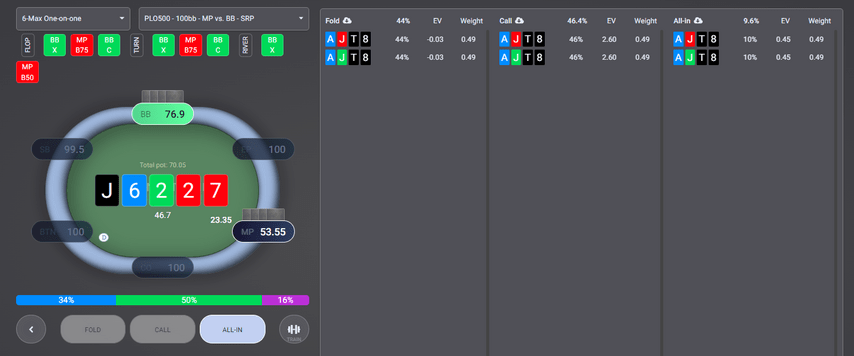
Here, catching a bluff seems completely counter-intuitive against the field, but the EV of calling is too high from the solver's point of view to completely abandon bluff catches. I think it's worth experimenting with calling against the right opponents. After a pot bet on the river, of course, we fold – you can only bluff catch when you catch, say, . But the eight is not a blank at all; it is strictly forbidden to give up on such a good card:
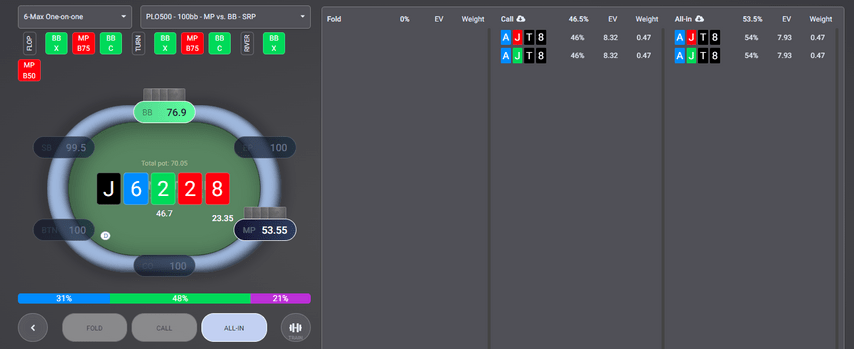
Another curious runout: the turn is an offsuit queen, the river is an eight. We check-call the queen without other options, it is quite reasonable and logical with our straight draws. And what do we do on the river, which gives us a second pair, but also allows us to bluff, representing a straight? Does our hand have enough showdown value?
Solver thinks so. We check and get ready to confidently open a bet in half the pot, but there is already a little not enough for a full pot:
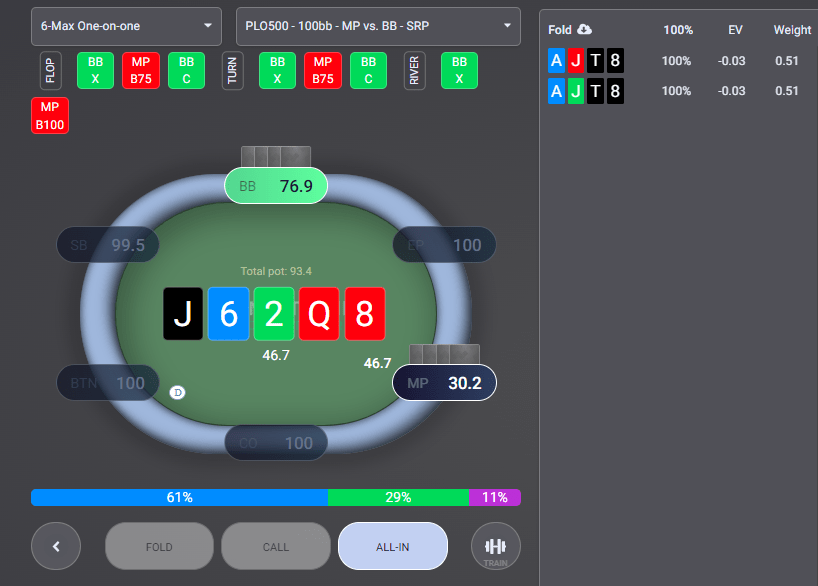
3)
Another nasty texture is ace-high with a pair. and the turn, for example, . It is clear that we tolerate a continuation bet to a third of the pot even with our not too strong kicker, but on a blank turn, when the opponent starts to polarize, even the machine does not want to continue:
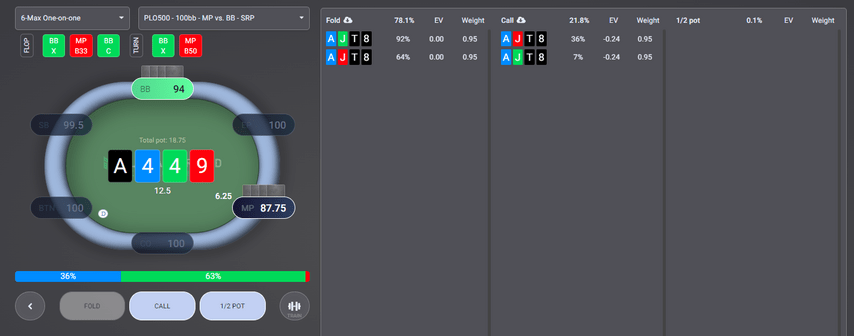
4)
Let's look at another texture that we didn't really hit, but our range should feel good.
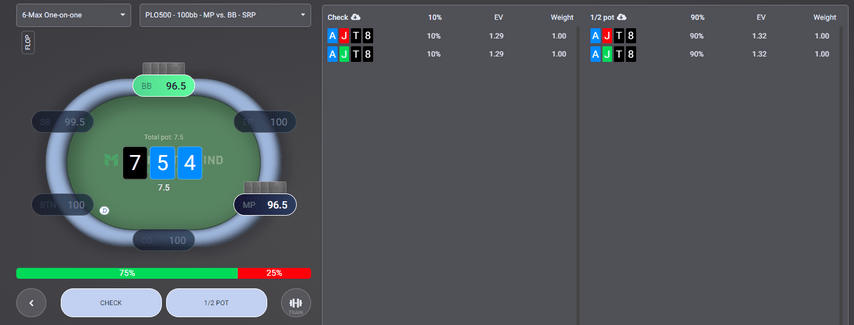
The Ace of Diamonds is such an important card that we don't even really need backdoor spades. We make a lead and take the pot much more often than we deserve. In principle, quite an intuitive action. However, on this texture, even an automatic check will not be a death sentence for us:
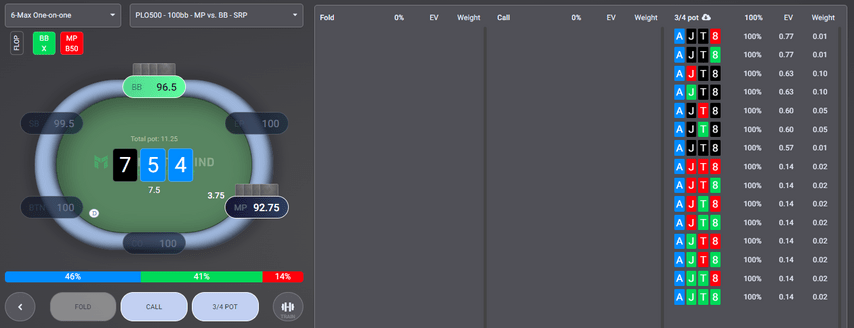
The solver always check-raises in response to a half-pot c-bet! Calculation for immediate fold equity.
Let's say our opponent endured our check-raise and called. Think about which cards you would like to continue aggression on:
A)
B)
C)
D)
e)
F) by no means
Correct answer -
Spoiler:
by no means! Our main line for all these cards is a check. Moreover, on the queen of spades, we simply play a check-pass for a half-pot bet, despite the flush draw, and on diamonds, of course, check-push. Finally, the nine is a great card for realizing equity through a check-call.
5) Low straight flops
Another texture where BB has a wide lead range is . Does the solver want to be aggressive with our hand? No, it doesn't want to. We don't need to force the position (to use a chess term) – just check and fold. But on it is already possible to both lead on fold equity (preferably) and check-call on implementation.
6) Flush draw flops
What is our plan for a weak flush draw? For example, on the flop ?
Yes, a simple question – of course, check and fold to a bet. The flush draw is too weak. We need more equity. For example, flops and , where we have equity other than a flush draw, are good for check-calling.
Okay, we defended and made a flush, is that the nuts? On the turn, yes, we always check-call. On the river, alas, it turns into a pumpkin. Even if it's the fourth flush:
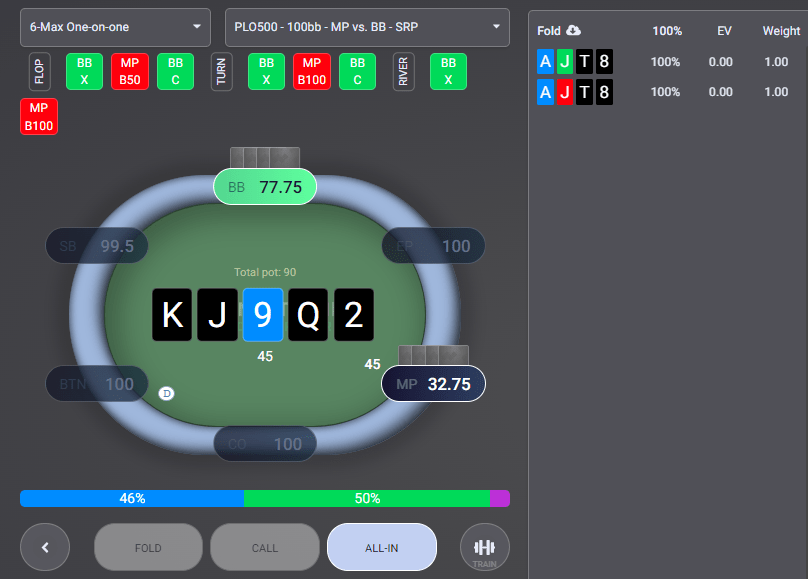
It is after such hands that it becomes especially disgusting: it seems that they did everything right and bought all the necessary cards, even in excess, but still they have to fold. Doubts arise: maybe it is not necessary to play this hand at all. However, the solver, as you can see, does the same without the slightest remorse and still brings it to a plus. So if mere mortals lose EV defending , then definitely in other lines.
KK42 with two small spades
1)
Dry flop, overpair + small pair, weak backdoor. It doesn't seem like much, but it's still a check fold to a c-bet. We can only continue with a strong backdoor – if our king was also a spade. Incidentally, without a pair (say with a hand ) suits no longer matter – fold immediately.
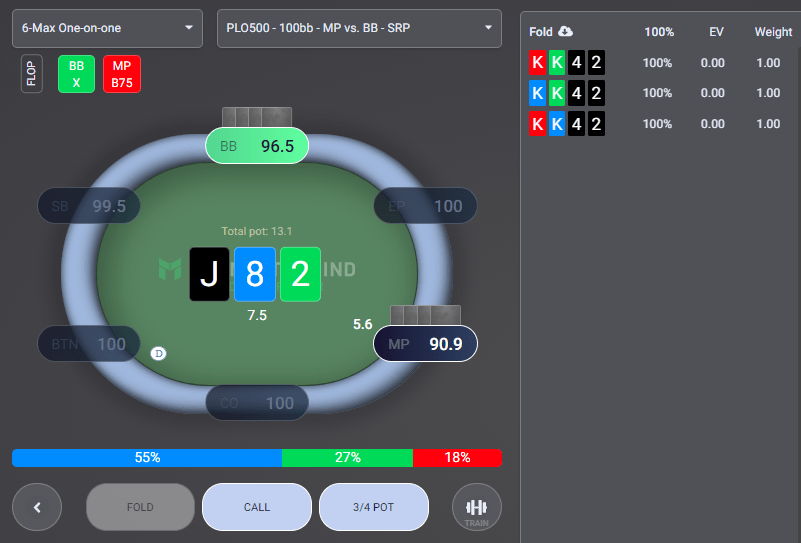
2)
Folding on the flop is unthinkable, at least not for a third-pot solver sizing. With our hand, the solver mixes frequent calls and occasional raises.
After calling and hitting a blank turn, we should obviously give up on the second barrel, but this decision, for all its correctness, seems to be much closer than it seems.
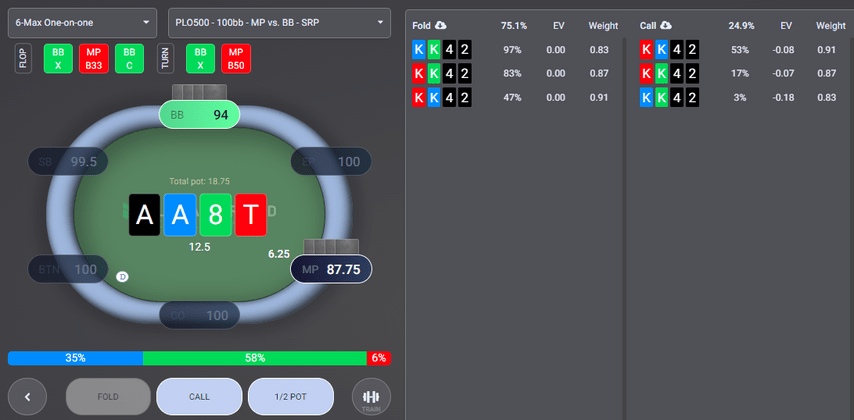
The solver even mixes in rare calls, albeit with a negative expectation. Of course, we will not do as he does. The second barrel can only be called after catching a four, a deuce, or a spade.
An interesting turn card is another ace. The solver sizing for the MP here is 3/4 of the pot and is clearly designed to make our kings indifferent to the choice between calling and folding.
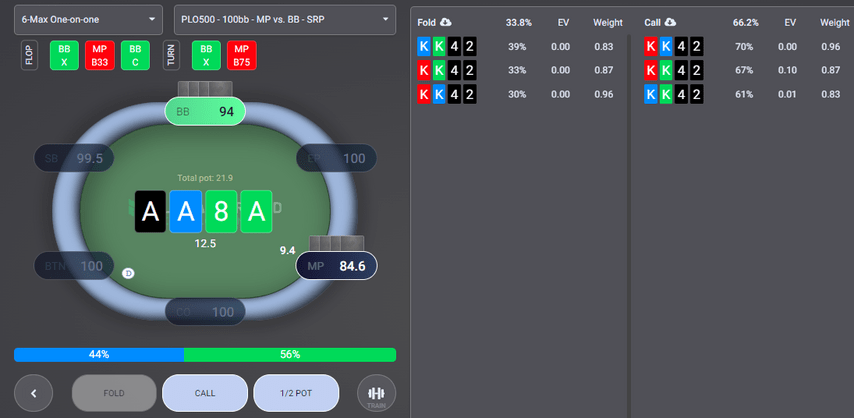
On the river on the third barrel, kings can be folded – for catching bluffs, one of a kind is enough for us.
2)
A flop that makes you want to bluff! However, you don't need to do this with a weak flush draw. Quietly check and call half the pot. But with the nut flush draw, we would have a good check-raise-fold! What do you think: how easy is it to come up with this variant of the draw during the session?
Okay, we got a continuation bet and called with our hand. Turn – , four cards to the straight, we have two blockers. How do we continue?
Here it is, the perfect moment to bluff: the solver in our place leads one-third of the pot!
Only a third? We won't make anything!
That's right, Villain only has 15% of folds for this size. But it's not a one-street bluff, it aims further. And on the blank river, and even on the diamond river, we confidently bluff with a full pot, and we can check-call on the spade. In my opinion, this is one of the most interesting and instructive moments in our selection, although everyone, of course, has their own weak points.
Other turns: surrender to the full pot on a blank (optimal sizing for the opponent), check-call a pot bet on a spade, and then think on a blank river – the solver mixes by randomizer, and we can choose between calling and folding depending on the characteristics of the opponent.
3)
Here's another straight flop that our blockers can take a toll on. They can, but they don't have to! The solver mixes half-pot leads and checks, giving a clear preference to checks (after all, the opponent hits this texture too well), and calmly falls off on a continuation bet. You could say fit-o-fold.
4)
We continue to see straight flops. We must have wild, unimaginable bluffs somewhere. For example, on – here we have a gutshot, and a backdoor draw, and a lot of leads ... Shouldn't we start bluffing aces?
On the flop, the computer says, this should not be done. What's more, our hand is strong enough to check-call!

A branch that is a little mysterious for me, because there are almost no turns that do not strengthen us, on which we continue to fight – except a second eight, you can pay half the pot with not very large pressure. Apparently, the clue is in the lines where both players check to the end – the solver hopes to win in them quite often.
Even on low street boards like or we don't need any sudden moves – we check, call c-bet, convert. If Villain polarizes the range on the turn by betting a big second barrel, give up. It all looks quite tight – people will definitely be able to play according to science!
5) Special offer for donk fans
If you definitely want to lead on some flops, here are a couple of more or less suitable ones:
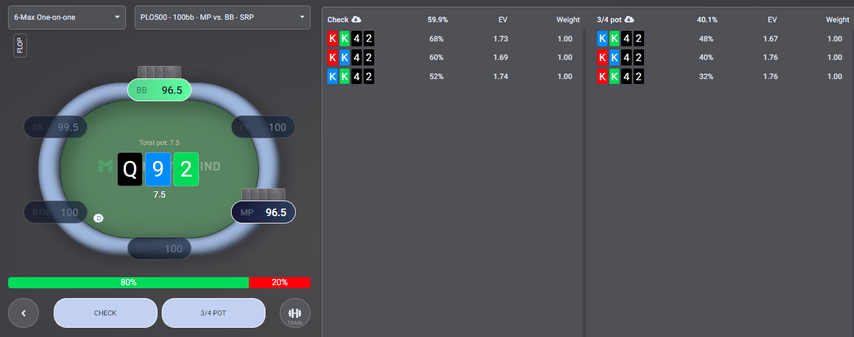
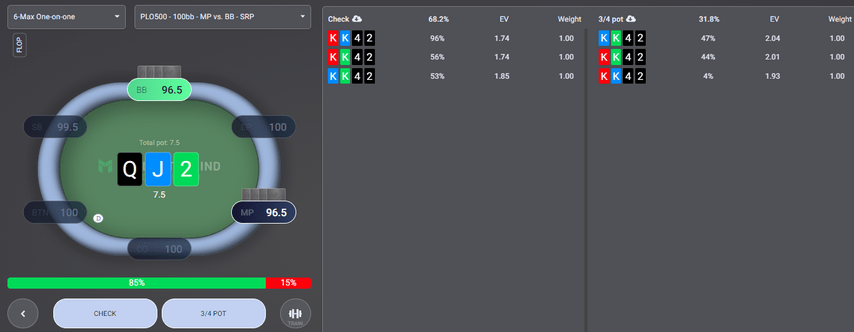
The main line of the solver is still a check-fold (if there is no low pair, it is the only one), but, as you can see, there are also leads that test the aces well: half of the combinations , with no gutshot or board pair, should immediately fold in place of the MP. We don't fold other hands stronger than ours, so after calling our turn equity is usually unenviable, but we can try to bluff if the straight closes!
6) Flushes
Well, let's finally touch on flushes, although you can probably guess what we do with them. Let's say the board is we confidently call a third on the flop, not too confidently (mixing with folds) tolerate a pot-bet on the turn, and on a pot-bet on the river we get rid of the weakest flush without hesitation.
7) What everyone hates
I don't want to study paired flops: there, even with normal, beautiful hands, it is completely unclear what to do, a balanced strategy is usually not subject to human heuristics. The good news is that the same problem is in full swing for everyone. Therefore, playing against an opponent on such textures is especially profitable, and in a vacuum, you can randomly press the buttons. I will only note such a supposedly instructive nuance:
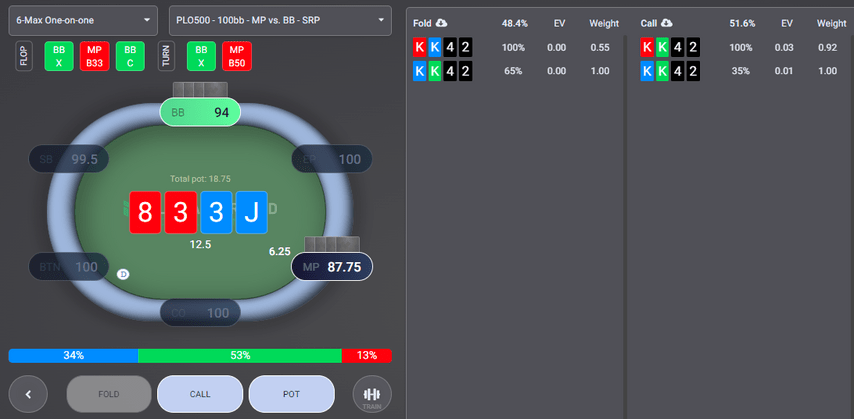
Against the second barrel, the EV of our kings is near zero, but without a king of diamonds, the solver always calls, and folds more often with a king of diamonds. This is because the machine barrels bluffs mostly with a second flush draw, the one that came on the turn, and prefers to check back with a heart. Therefore, when we block a diamond, our opponent will often have a stronger hand. You can remember in case you come across a fanatical GTO adherent. But there is a lot of money in this spot, I'm afraid, I still won't be able to win.
In general, it's not easy to play bad kings and it's hard to get EV in active lines – more often than not, we give up right away or call and fold on the next streets, ruining our schedule and mood. However, in passive lines, the value of the pair at the showdown, according to the logic of the solver, should slightly outweigh this minus.
If all or almost all of the solutions in this article seem simple and straightforward to you, I have good news for you: most likely, you can successfully defend the big blind not only with marginal hands but also with strong marginal hands. If the recommendations of the computer seemed complicated and incomprehensible, then your "chart" protection will be good news for someone else.


